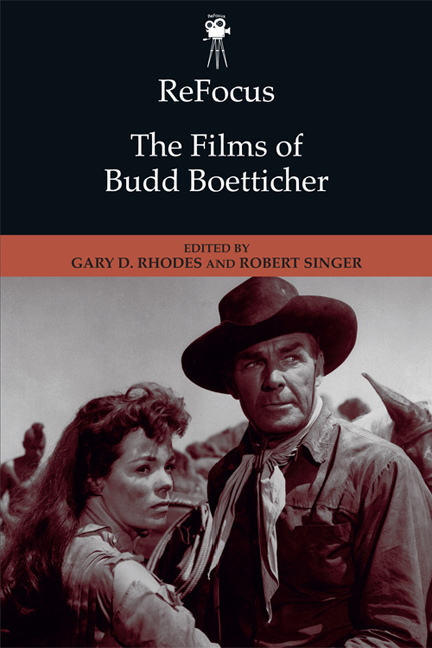Book contents
- Frontmatter
- Contents
- Notes on Contributors
- Dedication
- Introduction
- Part 1 The Non-Westerns
- Part 1 Introduction
- 1 “I never did think he was crazy”: Mystery and Criminality in Boetticher's Psychological Noirs
- 2 On Ethics and Style in Bullfighter and the Lady (1951)
- 3 Domestic Tension and Male Hysteria: The Killer is Loose (1956)
- 4 The Killer is Loose (1956) and the Televisual Dissolution of Film Noir
- 5 Adventures on the Small Screen: Boetticher, Warner Bros., and Maverick
- 6 The Signifying Heel: Boetticher's The Rise and Fall of Legs Diamond (1960)
- Part 2 The Westerns
- Index
2 - On Ethics and Style in Bullfighter and the Lady (1951)
from Part 1 - The Non-Westerns
Published online by Cambridge University Press: 22 December 2017
- Frontmatter
- Contents
- Notes on Contributors
- Dedication
- Introduction
- Part 1 The Non-Westerns
- Part 1 Introduction
- 1 “I never did think he was crazy”: Mystery and Criminality in Boetticher's Psychological Noirs
- 2 On Ethics and Style in Bullfighter and the Lady (1951)
- 3 Domestic Tension and Male Hysteria: The Killer is Loose (1956)
- 4 The Killer is Loose (1956) and the Televisual Dissolution of Film Noir
- 5 Adventures on the Small Screen: Boetticher, Warner Bros., and Maverick
- 6 The Signifying Heel: Boetticher's The Rise and Fall of Legs Diamond (1960)
- Part 2 The Westerns
- Index
Summary
One of the many ways in which scholars neatly try to simplify film history is to call American cinema “classical cinema” (or “classical narration”), at least in its pre-1967 era, and compare it with, for example, “art cinema.” This, however, is unsatisfying. In the alleged classical era tens of thousands of films were made in Hollywood in a great variety of styles, themes and ideas, and yet they are all summarized as “classical,” a generalization that hides the true diversity and scope of American cinema. There are films that are baroque, films that are opaque, films that are decadent, films that are absurd, surreal, and quite a few that would have been called, had they been European, “modernist.” Of course, such a discussion is meaningless without a proper definition of “classical” and so, in the context of this article, “classical cinema” is to be understood as a kind of cinema that has a linear narrative, unambiguous cause and effect, an unobtrusive visual style and that is not ironic.1 As should already be clear, many Hollywood films and filmmakers do not adhere to such a definition. Howard Hawks, Joseph H. Lewis, Robert Siodmak, Fritz Lang, Alfred Hitchcock, Vincente Minnelli, Otto Preminger and Frank Borzage, among others, make ample use of ambiguity, open endings, reflexivity, irony, techniques that draws attention to itself, and unreliable narration (when what is shown is not always to be trusted) in their films. Though they are seldom as radical as, for example, Jean-Luc Godard or Nagisa Oshima, and they do not use those techniques all the time, these filmmakers are much more complex than the conventional definition of “classical cinema” suggests. Similarly, many who are called “art cinema” directors, such as François Truffaut, Vittorio De Sica and Claude Chabrol, have more in common with the Hollywood filmmakers listed above than with the radicalism of Godard.
Where does this leave Budd Boetticher? His films do have a linear narrative, unambiguous cause and effect, an unobtrusive visual style and they are not obviously ironic so, in that respect, it could be argued that he is a director who actually does make films in the style of authentic “classical” American cinema.
- Type
- Chapter
- Information
- ReFocus: The Films of Budd Boetticher , pp. 28 - 39Publisher: Edinburgh University PressPrint publication year: 2017



